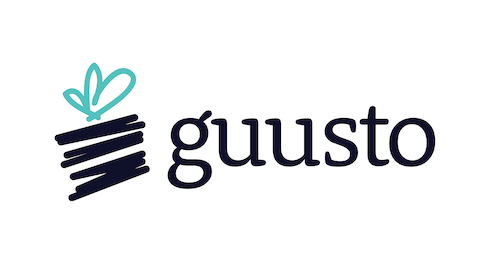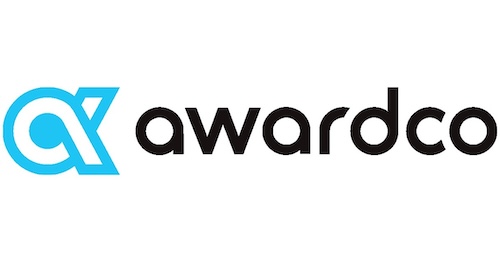Table of contents
ToggleShare this article
What is employee recognition software?
Employee recognition software platforms are a type of human resources (HR) program aimed at increasing employee retention and satisfaction through public and private appreciation. Most employee recognition systems also offer rewarding capabilities, like virtual gift cards, company swag, and other perks, to motivate excellent employee performance and collaboration with peers.
Integrating employee recognition software into your current HR tech stack is strategic since it doesn’t cover critical features like payroll and benefits administration. Instead, its goal is to improve the employee experience by fostering an inclusive, supportive, and positive company culture.
After reviewing 10 of the top employee recognition software options on the market today, I’ve narrowed it down to the best of the best:
- Bonusly is the best employee recognition software overall.
- Assembly is the best for employee engagement.
- Mo is the best for social recognition.
- Guusto is the best for businesses with frontline workers.
- Awardco is the best for fast-growing businesses.
- Honorable mentions: Motivosity, Kudos, and Nectar.
Disclaimer: TechnologyAdvice is not a tax service or agency. The portions of this article about tax withholding are for informational purposes only and are not intended as legal advice. Please consult with your tax expert for specific situations.
Featured partnersFeatured Partners
Our picks for the best employee recognition software
Bonusly: Best employee recognition software overall
Pros
- A 15-day free trial is available, unlike most competitors.
- Analytics are available in every price tier.
- Bonusly provides recognition rate benchmarks.
- The software integrates with many collaboration apps, including Slack, Microsoft Teams, Google Chat, Zapier, and Jostle.
Cons
- Financial reporting is limited to rewards spending.
- The platform is occasionally slow and glitchy, and the top menu bar sometimes loads incorrectly.
- HR software integrations are only available in the Pro tier and higher.
Bonusly focuses equally on employee appreciation and rewards features. Its international reward options and huge integration library make it a great choice for distributed teams wanting a quick way to appreciate peers without leaving the tools they use every day. This, plus its transparent, competitive pricing, makes it the top-scoring platform in our roundup.
Because Bonusly’s interface mimics social media platforms like Facebook and X, it’s easy for most users to learn. A central newsfeed populates with your company’s recent “bonuses” or recognition posts between employees, which you can filter by teams, departments, or locations to focus on the activity important to you. You can also make bonuses more engaging with GIFs, images, and emojis or more meaningful with hashtags connected to your company’s values.
Like most recognition and rewards platforms, Bonusly uses a points system to reward employees for their good deeds and performance. Users receive points each month to give to their peers, which they can accrue and exchange for rewards of their choice. Reward options include virtual gift cards, charity donations, company swag, cash-out options, or custom rewards, like extra paid time off (PTO).
Bonusly also emphasizes connecting recognition to rewards and your company values. The keyboard shortcuts “@,” “+,” and “#” let you quickly give points to a recipient, tie them to a company value, and post. Bonusly advertises rewards you might like on the right side of your homepage and automatically reminds you to give points from your monthly allowance to others.
Bonusly’s features might be appealing if you want to offer more valuable gift options to your employees to motivate team collaboration and high performance. But, if you’re a small company that lacks the budget for consistent rewards redemptions, you might prefer platforms like Assembly, where you can toggle monetary rewards on and off. Or, you might appreciate platforms like Awardco with more in-depth budget controls.
Looking for more information on Bonusly? Check out our Bonusly vs. Kazoo comparison deep-dive.
Automations
Bonusly offers automated recognition and rewards for employee birthdays, work anniversaries, and new hires. Although this functionality is standard in most recognition software, automations combining public recognition and rewards are usually part of higher price tiers. For example, Assembly doesn’t offer birthday or anniversary automations until its third price tier.
If you have a lean HR team, this helps with consistency and takes the manual effort out of recognizing staff for these milestones. Managers strapped for time can also ensure their team is recognized while juggling various company priorities.
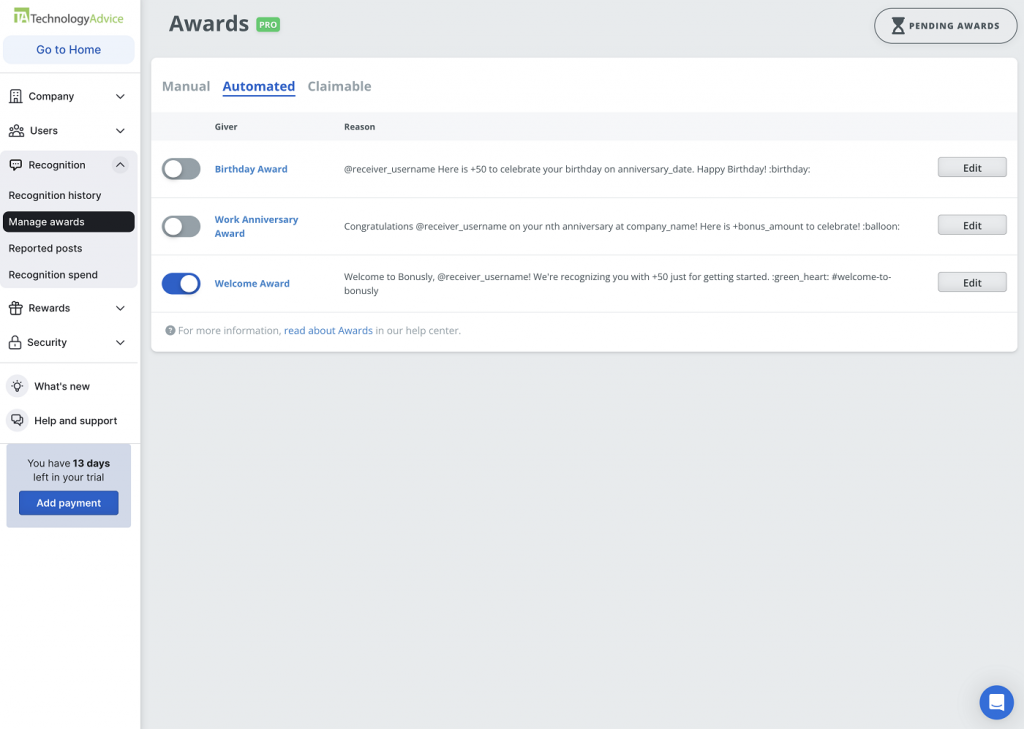
Expanse of features
Bonusy offers basic recognition, rewards, and analytics in all its price tiers at a more competitive price than competitors like Awardco. You can even add your company’s logo and colors to the platform to create a more professional-appearing platform in line with your brand without paying for an enterprise-grade solution.
Its features are also very user-friendly, with quick options and simplified instructions so that it takes little time to add in a customized award or offer different rewards based on the employee’s years of service. While this might not satisfy companies wanting more depth of customization in specific areas, like running automated employee of the month nominations, Bonusly’s basic controls make it more accessible.
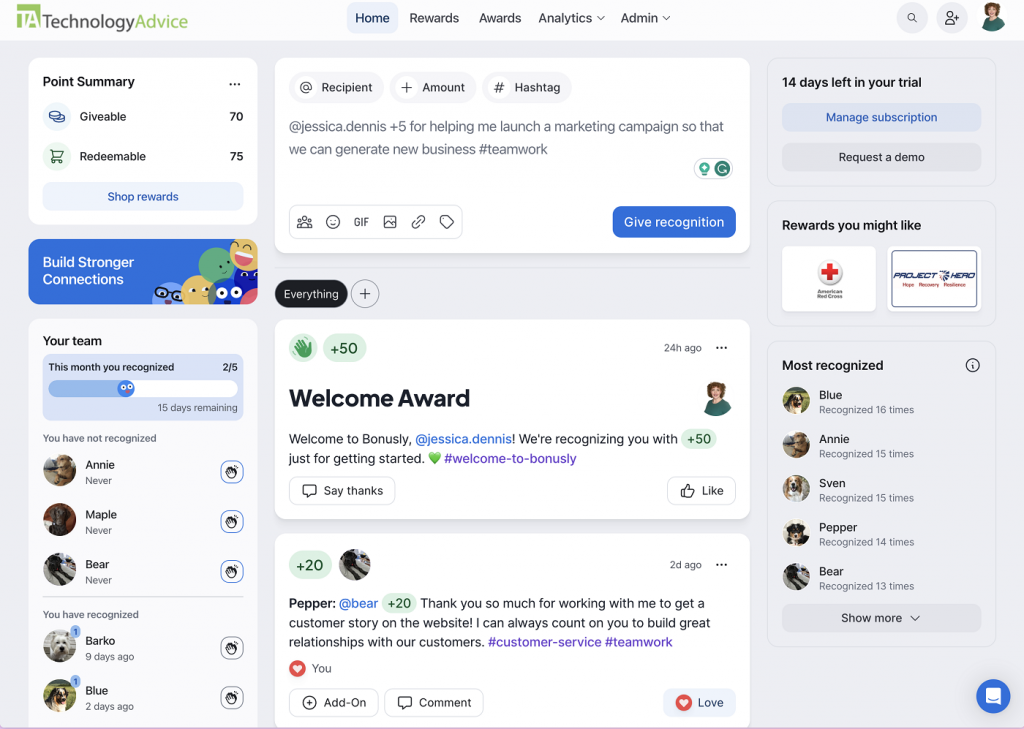
Bonusly offers three price tiers: Core, Pro, and Custom. As you scale up, you can access all of the features included in the previous tiers.
| Core | Pro | Custom | |
|---|---|---|---|
| Price (billed monthly)* | $3/user/mo. | $5/user/mo. | Call for a quote. |
| Price (billed annually)* | $2.70/user/mo. | $4.50/user/mo. | Call for a quote. |
| Main features |
|
|
|
*Note: These prices do not include the additional costs of any rewards your employees redeem, which Bonusly bills at the end of every month. Bonusly does not mark up rewards.
Bonusly’s pricing is most competitive if you have fewer than 70 employees. Otherwise, platforms like Awardco’s Lite SMB plan might be a better option; however, the Lite plan requires an annual contract and lacks peer-to-peer recognition capabilities.
With a 15-day free trial, product tours, and the ability to cancel at any time, Bonusly is an appealing choice if you want to test the effectiveness of employee recognition programs for your business without breaking the bank.
Bonusly is an excellent choice if you’re new to employee recognition software or looking for an affordable solution to celebrate your employees and incentivize their hard work. With three pricing tier options, your recognition capabilities can become more advanced as you grow.
Bonusly lost points in our overall score for its lack of platform customization features, which are hallmarks of enterprise-grade or niche platforms like Mo and Guusto. However, if you value quick implementation and pre-configured workflows, the white-glove support Bonusly offers in its Custom price tier might meet your needs.
Assembly: Best for employee engagement
Pros
- A free plan is available.
- The Premium tier includes dedicated support and implementation experts.
- The Dora AI assistant offers unique productivity advantages.
Cons
- The user interface has a moderate learning curve.
- The least expensive paid tier option has a maximum of only 20 users.
Assembly combines elements of employee recognition, employee experience, employee engagement, surveying, and performance management software. Its goal is to create workflows for these diverse capabilities without requiring expensive standalone products that create a disjointed digital experience for employees.
As a result, Assembly works best if you already have a basic human resources information system (HRIS) or payroll system and want to augment these tools with software that makes the workplace more fun. Assembly shines in its ability to recognize employees through a mix of traditional and nontraditional methods.
For example, Assembly offers typical employee recognition features, like:
- Recognition tied to company values.
- Virtual gift cards, charity donations, and company swag.
- Custom experience rewards, like a pizza party or concert tickets.
- Nominations for awards like employee of the month.
But Assembly also includes employee engagement features, like workplace games, icebreakers, contests, and challenges. It even allows employees to blur the line between their personal and professional lives. You can use workflows like Dream Journal, Daily Affirmation, Mood Tracker, or Sleep Tracker to help employees monitor these goals privately or share their responses for public engagement.
Other creative engagement options include culture committee or employee resource group (ERG) creation forms, cookie-baking contests, or — my personal favorite — desk decorating contests. These allow employees to get to know their coworkers with some healthy competition and celebrate accomplishments outside of work. If you’re on a budget, this can be an effective way to build your workplace culture and community without expensive reward options.
Assembly’s score was diminished because it lacks sitewide reporting in lower price tiers. Its interface also takes longer to get used to since its homepage includes tabs for task management, recordkeeping, and announcements unrelated to recognition and rewards.
Additionally, Assembly requires you to go through a multi-step workflow to give recognition or make a post, which takes extra time compared to more straightforward platforms like Bonusly. Nevertheless, Assembly stands out for its various engagement options for teams that want to start appreciating their teams and increase platform adoption rates.
You can explore more of Assembly’s features in our comparison post Assembly vs. Kudos. Or, check out our video overview:
Employee surveying
Assembly offers employee surveying capabilities for strategic initiatives like gauging employee satisfaction or tactical measures like planning your next company potluck. You can create new surveys from scratch or leverage pre-existing templates for culture, onboarding, engagement, benefits, eNPS, pulse, or exit surveys. You can also set them up on a recurring schedule to monitor sentiment over time with little administrative effort.
Assembly lacks some of the robust capabilities of a full-scale surveying platform, such as skip logic question types and anonymity thresholds. However, Assemby’s relatively easy implementation makes it a better choice if you need a systematic way to collect employee feedback.
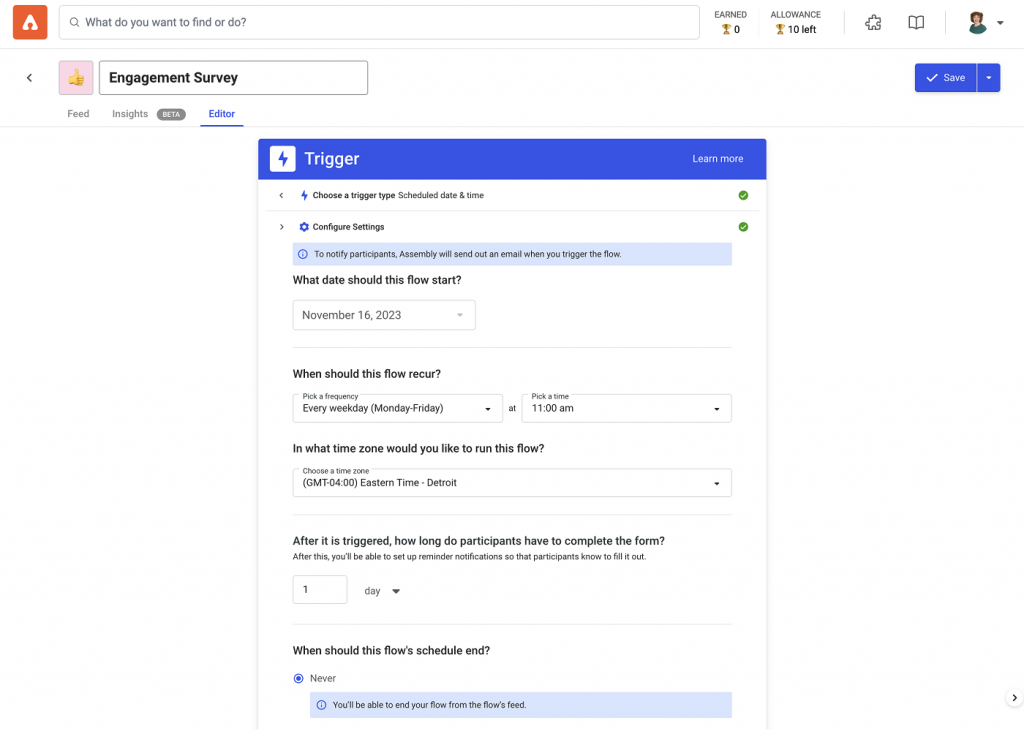
Workflow templates
Assembly uses “flows” to complete any process on the platform, such as posting a company announcement, rewarding employees, or conducting 360-degree performance reviews. You can customize your own flow or take advantage of Assembly’s template library to add on a new process.
Assembly’s flows are less sophisticated than all-in-one HR software platforms like Rippling. For example, automatic workflow triggers are only based on date and time, not on event variables like an employee’s start date. However, Assembly can automate recognition programs — like posting daily questions to prompt peer engagement — more systematically than others in our roundup.

Employee experience features
Assembly includes employee experience software features like internal communication options and document storage. You can also integrate with your HR software, ticketing system, collaboration apps, and other tools to streamline work information.
One of Assembly’s most useful employee experience platform features is its global search function, which allows you to quickly find information from all your integrated tools. Meanwhile, Assembly’s Dora AI assistant can summarize document information or answer specific questions to speed up your employees’ work processes.
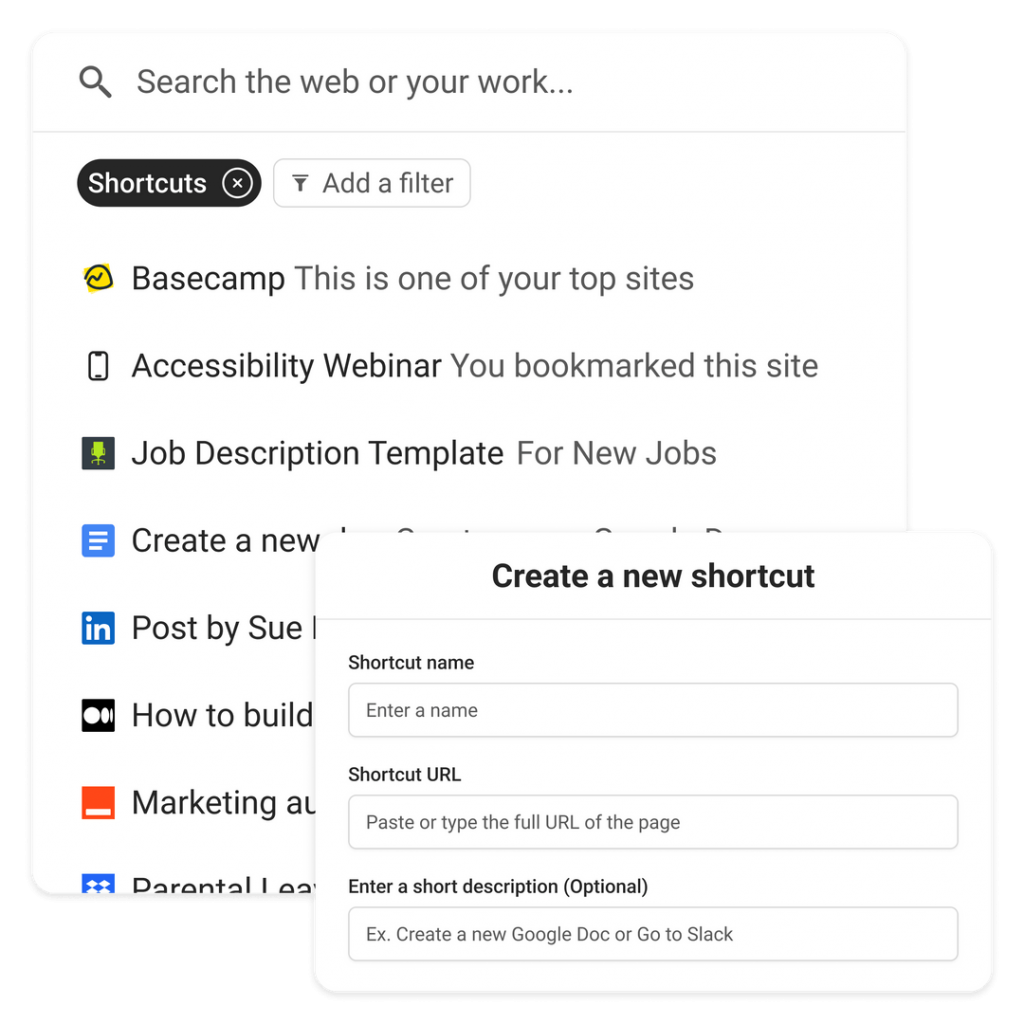
Assembly offers four price tiers: Starter, Lite, Standard, and Premium.
| Starter | Lite | Standard | Premium | |
|---|---|---|---|---|
| Price (billed monthly) | $0.00/member/mo. | $3.50/member/mo. | $6.00/member/mo. | Call for a quote. |
| Price (billed annually) | $0.00/member/mo. | $2.80/member/mo. | $4.50/member/mo. | Call for a quote. |
| Max number of members | 5 members. | 20 members. | Unlimited. | Unlimited. |
| Main features |
|
|
|
|
Assembly stands out for its free Starter plan, which supports rewards and recognition workflows from the start. However, its free plan only allows for a maximum of five users, meaning it only works if you’re a very small business or want to issue recognition and rewards on an impromptu basis. Still, you’ll have to add and remove members to do this, making it difficult to establish a culture of recognition.
Assembly’s Lite plan has 20-user cap and offers only a few more capabilities than the Starter plan. Because of this, Assembly aims for customers to purchase its Standard tier, which is expensive compared to Bonusly, Awardco’s SMB plans, and Mo. But if you’re hoping to build a rudimentary employee intranet and recognition program, Assembly is less expensive than full-scale employee experience solutions.
Assembly earned a total of 3.77 out of 5, making it the second-highest scoring platform in our roundup. It won me over because of its various engagement features that encourage employees to applaud each other in non-conventional ways, like through contests. If you have a small, distributed workforce, these can be great ways to foster peer collaboration and appreciation organically.
While Assembly lost points for its interface, you may like its ability to customize workflows, shortcuts, and settings to fit you and your employees’ processes. With an easier way to search and find information, connect with colleagues, and accomplish work, Assembly can replace your other productivity tools, streamline work, and increase employee retention.
Mo: Best for social recognition
Pros
- Ability to send out company announcements through its social feed.
- Automatic nudges to encourage posting and peer recognition.
- Multi-currency support for international rewards options.
Cons
- Advanced reporting and analytics in Level Up plan.
- Rewards options are only available in Level Up plan and higher.
- Limited integrations outside of Slack, Microsoft Teams, and SSO vendors.
Mo — short for “moments” — focuses on elevating the employee recognition experience through social-media-like features. The platform’s centralized newsfeed and rewards buttons are reminiscent of Bonusly, but Mo places a much bigger emphasis on learning, sharing, and collaboration.
In addition to liking, sharing GIFs, and commenting on recognition posts, users can save meaningful posts in a highlight reel to reference later in performance appraisals. Customized lists let you group employees based on more than their department or location, which makes it easier to praise new hire cohorts, cross-functional teams, and other multi-faceted groups.
Employees also have the option to share recognition publicly or privately, accommodating employees who are uncomfortable in the limelight. You can even follow colleagues like you would on Instagram or LinkedIn to keep track of their activity and support their accomplishments.
Another notable feature is Boosts, or nudges to prompt social engagement. Like Assembly’s flows, Boosts can be as simple as reminders to recognize someone. They can also be a theme, like “Lessons Learned,” which employees can respond to with their insights. Moreover, users can complete Boosts in far fewer clicks than Assembly, making it easy to inspire responses.
However, Mo might be too expensive if you’re primarily looking for a tool that supports employee rewards. All other vendors in our shortlist offer rewarding options to start — Assembly even does so in its free tier. You’ll have to upgrade to get this functionality with Mo, which may be cost-prohibitive.
However, if your main goal is building employee connection, Mo scores the second highest in its employee recognition features at 4.48 out of 5. Only Bonusly beats Mo because it offers more integrations with collaboration tools like Slack. Otherwise, Mo provides a more engaging user experience than Bonusly.
Personalized profiles
Mo lets you personalize your profile with your picture, hobbies, working preferences, interests, languages, headlines, and pronouns. For a little extra pizzazz, you can also change the color of your profile banner and pin your favorite appreciation posts for others in the organization to see.
Profiles are a great way to learn about coworkers before tackling projects together. They can also help build work friendships that improve employees’ sense of belonging.
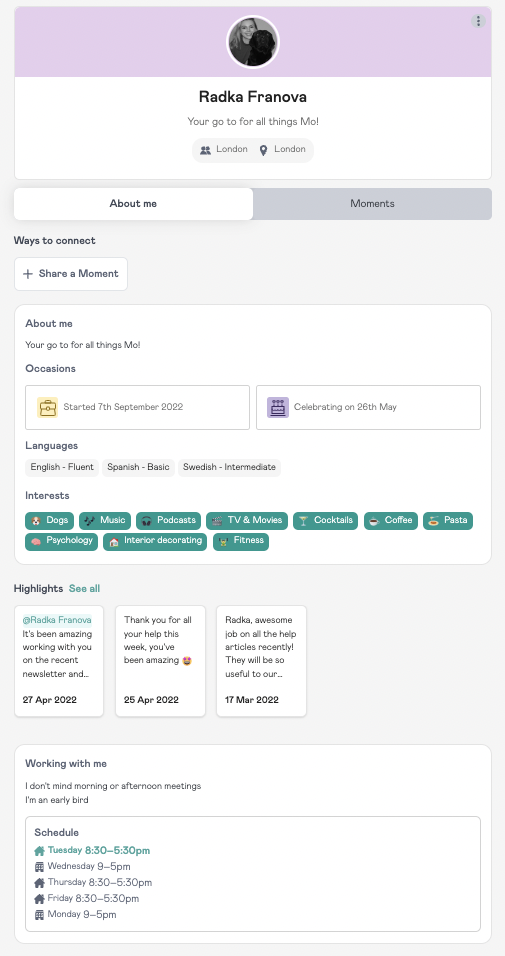
Challenges and ideas
Mo lets decision-makers pose challenges to broader teams regarding struggles, issues, or problems the company faces. For example, a challenge could be deciding this year’s holiday party theme or next year’s company training topics. The goal is to crowdsource ideas and increase involvement and social input.
You can choose who can see and respond to challenges. But, posing challenges to your whole business can be a great way to demonstrate transparency and encourage folks to share their perspectives regardless of where they are on the org chart.

Mo offers three price tiers: Starter, Level Up, and Custom. The table below lists Mo’s pricing in American dollars, but separate pricing in British pounds is also available.
| Starter | Level Up | Custom | |
|---|---|---|---|
| Price (billed monthly) | $3/user/mo. | $5/user/mo. | Call for a quote. |
| Price (billed annually) | $2.70/user/mo. | $4.50/user/mo. | Call for a quote. |
| Main features |
|
|
|
On the surface, Mo’s pricing is similar to platforms like Bonusly and Nectar. However, critical features like rewards and chat app integrations are limited to the Level Up and Custom tiers, which means you have to pay more just to access reward capabilities on top of the costs for the rewards themselves. If you need a balance of recognition and rewards, look to Assembly or Bonusly instead.
If you have a small, remote team, Mo can break down barriers by providing a fun, social outlet for getting to know colleagues. Its customizable social wall, profiles, and highlight reels earned high marks in our recognition scoring category ahead of everyone but Bonusly.
Mo is also great if you want to test drive recognition software before complementing it with rewards and incentives. Its Level Up plan is less expensive than Assembly’s Standard plan but has a much more manageable interface, which may encourage higher employee usage rates.
Guusto: Best for frontline workers
Pros
- The platform supports random prize drawings for surprise gifts.
- Sending rewards supports clean drinking water through a partnership with OneDrop.
- Customer-focused teams can create external rewards programs.
- A free tier plan is available.
Cons
- HRIS integrations are only available in its Premium plan.
- The software does not integrate with Slack.
- Peer recognition features aren’t available in the Free and Lite tiers.
All employees can engage with Guusto’s user-friendly interface, regardless of device type or technical expertise. This level of accessibility makes the platform ideal for frontline workers.
If you only have a few employees, you can start sending ad hoc virtual gift cards via Guusto for free. Sending gifts takes less than 30 seconds, and you can personalize the messages with images, GIFs, your company logo, and colors. Plus, if you enter your recipients’ contact information into Guusto ahead of time, the app will remember and autofill it for you to make the process even faster.
However, Guusto has the opposite problem of Mo — its focus on rewards comes at the expense of its recognition elements. The platform only earned 2.5 out of 5 for recognition because you need to purchase its Essential plan for public employee shoutouts. Even then, the restriction of 20 seats means you’ll have limited peer recognition options if you have a large team.
But, such widespread recognition may be impractical if you mostly employ frontline workers anyway. In that case, Guusto is great for starting and managing a simple rewards plan.
Reward redemption options
Employees can create a Guusto account to accrue monetary gifts and exchange them in the app for gift cards, charity donations, travel perks, or subscription services of their choice. Alternatively, you can print out gift cards for employees who don’t have an email address or wish to avoid creating a Guusto account. This is a great way to thank frontline and tech-averse employees for their hard work without extra fuss.
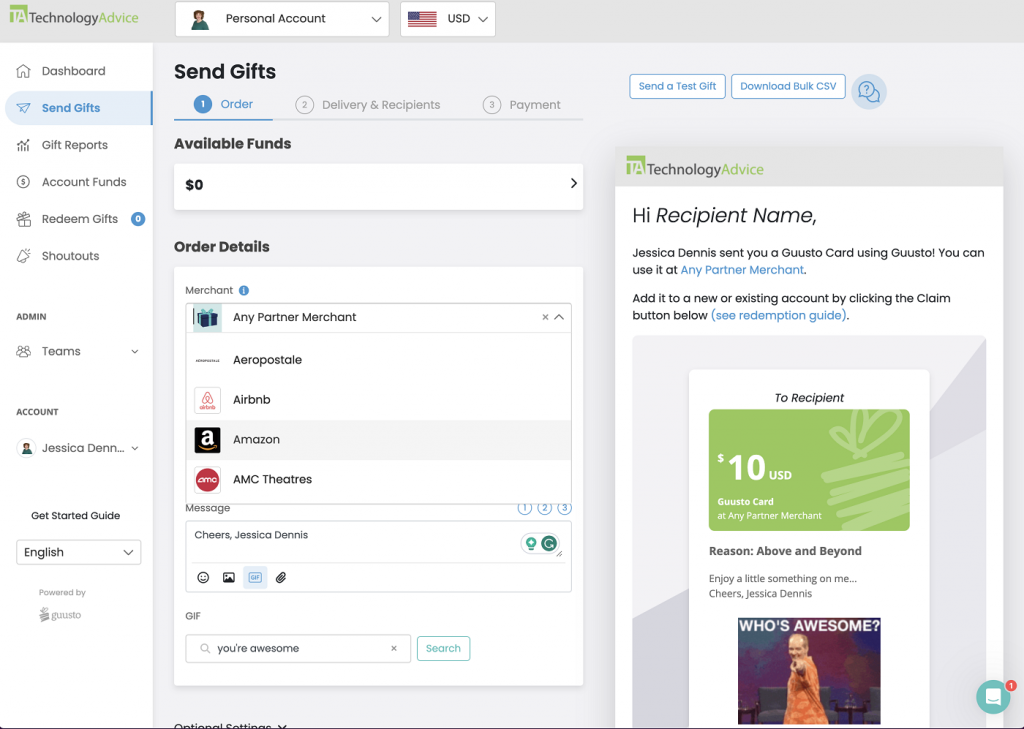
TV display
Guusto can display real-time recognition and other data on a smart TV, effectively creating digital signage for your deskless workers. All you have to do is enter a special URL into your smart TV’s web browser to pull up a reel of the last 100 recognition posts that refreshes every five minutes.
You can customize what shows to the right of the recognition feed, like a company bulletin board and celebration milestones. By setting up the TV display in a break room or common area, frontline employees can see words of recognition without connecting to a computer.
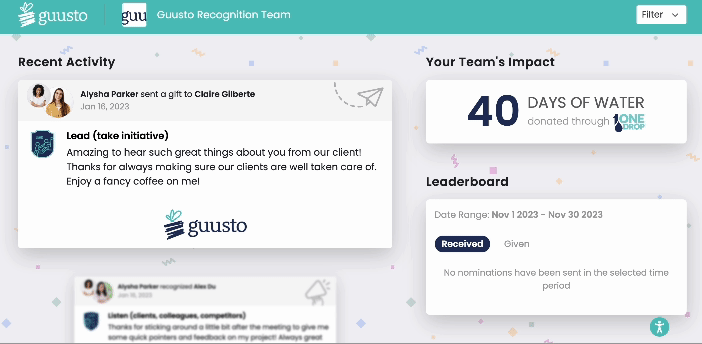
Guusto offers four pricing tiers: Free, Lite, Essential, and Premium. Unlike most employee recognition platforms, Guusto bases its pricing on the number of seats — or those who can give recognition — and not the number of total users.
| Free | Lite | Essential | Premium | |
|---|---|---|---|---|
| Price (billed monthly) | $0/mo. | $48/mo. | $96/mo. + $4.80/mo./additional seat. | $480/mo. + $6/mo./additional seat. |
| Price (billed annually) | $0/mo. | $40/mo. | $80/mo. + $4/mo./additional seat. | $400/mo. + $5/mo./additional seat. |
| Included number of seats | 1 | 1 | 20 | 80 |
| Main features |
|
|
|
|
If you do the math, Guusto costs between $4.00 and $6.00 per user, per month if you choose the Essential or Premium plans. This is comparable to Bonusly, Assembly, and Mo’s higher-priced plans. However, if your main goal is to foster peer-to-peer recognition, all three platforms have lower-priced tiers with built-in peer-to-peer recognition features, which Guusto does not.
But Guusto is by far the most affordable choice if you want to send rewards to employees and don’t want a full-scale recognition program — yet. You can add more recognition and internal communication features as you grow by moving up Guusto’s pricing tiers.
Guusto accommodates the needs of frontline workers by giving them multiple ways to redeem gifts, even without a computer. Likewise, businesses that don’t have the budget to manage a robust rewards program start small with Guusto for free.
Guusto’s lack of public recognition and award features in its starting price tiers heavily impacted its overall score, resulting in a 3.29 out of 5 overall. But, I was impressed by its easy-to-navigate interface and intentional features to accommodate workers who don’t use technology daily.
Real-world users also like it. At 4.9 out of 5 in user reviews, Guusto outscores the others in this category. In fact, between the over 2.5k reviews on G2 and the 1k reviews on Capterra, only five users rated Guusto lower than three stars, with a vast majority giving it five stars.
Awardco: Best for fast-growing businesses
Pros
- Deloitte consultation partnership for understanding global tax obligations.
- Offline recognition options.
- Recognition through customizable MemoryBooks.
- 24/7 customer support.
Cons
- Expensive option with no free trial.
- Custom integrations and physical rewards are only available in the most expensive enterprise Pro plan.
Awardco is this shortlist’s only employee recognition software with features catering to both small and enterprise businesses. This flexibility makes it attractive if you expect to grow quickly and want a platform that scales with you.
For example, the IRS considers gift cards and other monetary rewards taxable income, so you must report and withhold those amounts from employees’ paychecks. If you’re a small business that gives gifts occasionally or uses an outside payroll provider, Awardco’s Redemption Details Report can help you figure out your employees’ tax responsibilities. You can even export, manipulate, and send the report to others as needed.
But, as you expand or add an international workforce, tax concerns become more complicated. In that case, Awardco offers an in-app integration with Deloitte, which you can leverage for tax insights, plus in-person or virtual consultation services. Moreover, they can advise you on tax concerns in 20 countries.
There’s also much to like about Awardco’s recognition and rewards features:
- Integration with Amazon Business so employees can choose and ship physical gifts from Amazon fulfillment centers worldwide without worrying about customs or import fees.
- Integration with Priceline for employees to reserve and pay for hotels with their reward points.
- Customized digital MemoryBooks from managers and peers to celebrate employees’ work anniversaries.
- Scannable codes to gift points to employees who do not work at a desk.
That said, Awardco’s default homepage is relatively minimalistic and requires you to click on separate tabs to recognize someone or access its social recognition feed. But its clean look and ability to customize almost every aspect of the program impressed us — so much so that its interface score of 3.85 out of 5 is the highest on our list.
Learn more about Awardco in our video overview:
Scalable plans
Awardco deliberately offers separate plans for SMBs and enterprise businesses. Each plan builds upon the last by providing access to more customization, automation, and integration capabilities. As your headcount grows, these features can help you automate administrative features and improve efficiency.
Although it’s expensive to start if you have less than 50 employees, Awardco’s pricing is quite competitive with other employee recognition tools. This is especially true if you have 100–300 employees. Awardco does not charge per user, so you can more employees to the platform without worrying about a price increase.
Budget controls
All Awardco plans include basic budget controls for planning your reward spend directly within the app. This is unlike other vendors that require you to use external calculators or spreadsheet programs to create budget plans.
In contrast, Awardco offers granular options to manage and monitor reward spending. After loading reward points into the system, you can allocate them to various budgets, such as birthdays or anniversaries. You can even specify who can access each budget by role, department, location, or other employee metadata.
These controls ensure you always have points to fund employee rewards and ensure managers track their gift processes. Awardco even includes tax buffering features to help you plan for rewards with add-on costs, like sales taxes and shipping fees.

White labeling and customization
Awardco lets you add your company logo and colors to everything, including a customized homepage banner your employees see when they log in. Although Awardco doesn’t offer a mobile app, you can customize its responsive web app with your company colors and images to provide brand consistency across all devices.
Moreover, Awardco lets you customize your homepage’s widgets to fit your company’s style and workflows. For example, if you have an active workplace community, turn on Awardco’s homepage recognition and social feed widgets so employees can praise others with fewer clicks.
Or, you can add your own copy and images that employees can see by scrolling down the page, allowing you to create a platform experience unique to your organization’s culture and employees.

Awardco offers two pricing plan categories: SMB and enterprise plans. Each category has tiered pricing plans that add more features and capabilities as you scale.
| SMB plans (Up to 300 employees) |
|||
|---|---|---|---|
| Lite | Go | ||
| Price (billed annually) | $2,500/yr. | $4,000/yr. | |
| Main features |
|
|
|
| Enterprise plans | |||
| Core | Plus | Pro | |
| Price (billed annually) | Call for a quote. | Call for a quote. | Call for a quote. |
| Main features |
|
|
|
Although Awardco offers plans for small and large companies, it scores the worst for pricing. This is because Awardco does not disclose pricing for its Enterprise plans, does not offer a free trial, and requires an annual contract.
Awardco is the most cost-effective if you’re recruiting quickly and want a recognition and reward program to connect your rapidly increasing workforce. Otherwise, starting with something like Assembly or Guusto might be more affordable if you have very few workers and want to test the effectiveness of recognition software before investing.
Awardco is a versatile app with full-scale customization and unique rewards options that range from virtual gift cards to travel perks and experiences. With its different pricing tiers for SMBs and enterprises, Awardco can expand with you, offering creative ways to build community and entice employees to do good work.
Awardco has the lowest score on our list because you must pay for its higher-priced tiers to access some of the most critical features of employee recognition software, like peer-to-peer recognition. However, the price can be worth it because these features are considerably more robust than those of vendors with out-of-the-box configurations, like Bonusly.
Honorable mentions
Several employee recognition apps had similar scores to our favorites. If the top five don’t quite fit your needs, one of our honorable mentions might.
Motivosity: Best for manager development
Alternative for: Assembly or Mo.
When to choose Motivosity: If you’re looking for an all-in-one employee engagement and recognition platform with manager development features like AI to assist managers with writing praise, constructive criticism, and meeting agendas.
Why it didn’t make the list: You have to purchase Motivosity’s base community and connection module plus its recognition and reward add-on for access to all of its appreciation features. This makes it more expensive to start than Assembly.
Motivosity is one of our favorite employee engagement platforms because it offers strategic and tactical ways to combat employee disengagement. Learn more by checking out our Employee Engagement Software Guide.
Kudos: Best for enterprises
Alternative for: Awardco.
When to choose Kudos: Choose Kudos if you are already an established enterprise and want to transition to a program you can customize through white-labeling, open API, and interface widgets.
Why it didn’t make the list: Kudos does not disclose its pricing, so it’s hard to compare its cost-effectiveness to competitors with transparent pricing and features like Awardco.
Nectar: Best employee recognition program for first-time users
Alternative for: Bonusly.
When to choose Nectar: Use Nectar if you want to start recognizing and rewarding employees immediately with a simple interface and analytics features included in both price plans. Employees also have access to a corporate discount program.
Why it didn’t make the list: Nectar costs the same as Bonusly for a month-to-month subscription but has a minimum monthly charge of $99. This means you pay more for Nectar than competitors like Bonusly if you have fewer than 33 employees.
Dec. 13, 2023: Kaiti Norton fixed a formatting issue on the pricing tables for each vendor and clarified the cost analysis of Guusto’s peer recognition features.
I picked my choices with you in mind.
First, I conducted market research based on current options and narrowed down my list based on the reviews of readers like you. I then researched the following 10 employee recognition software using free trials, demos, and knowledge bases.
- Nectar.
- Awardco.
- Bonusly.
- Assembly.
- Motivosity.
- Kudos.
- WorkTango.
- Mo.
- Guusto.
- Cooleaf.
My research focused on your top-of-mind concerns like price, integrations, and analytics capabilities. Below is a breakdown of the categories I used to grade each platform. Each category also includes my expert score, which contributes to its overall score.
As the market changes, we reevaluate our choices so you always receive the best insight for your purchasing decision.
User reviews: 10%
User reviews from third-party software platforms like Capterra and G2 accounted for 10% of the software’s overall score. I focused on software that received at least 3.5 out of 5 stars on these sites. Because users have real-world experience with each platform, they played a significant role in narrowing down my list of top products to compare.
Pricing: 20%
Pricing accounts for 20% of my weighted score for employee recognition software. Software with transparent pricing, discounts, free trials, and free plans received the highest scores. I also considered each platform’s “value for money,” which determines whether the number of features in each price tier or module is competitive with other vendors in the space.
Platform and interface: 15%
How easy is the platform to use? Will it be able to grow with me? What is the customer service like? And will employees’ data be safe? This category covers the intrinsic features of most software platforms and vendors, including how well they will integrate with your current tech stack. This category represents 15% of each platform’s total score.
Reporting and analytics: 15%
Understanding the success of your employee recognition programs requires robust analytics uncovering the frequency of peer-to-peer recognition and financial insights into your rewards spend. I also rated platforms higher for dashboard variety, the ability to customize, and reporting capabilities in all price tiers. Reporting and analytics account for 15% of the software’s score.
Recognition: 25%
Recognition accounts for the highest percentage of the platform’s total score at 25%. I considered the number and scope of recognition features in each platform, plus its ability to automate appreciation for milestones like birthdays, work anniversaries, or onboarding. Platforms also received higher scores for integrations with chat or collaboration platforms like Slack or Microsoft Teams, preventing users from switching between apps to recognize their peers.
Rewards: 15%
Employee recognition software with monetary and non-monetary reward options earned higher marks than competitors. Additional features like international rewards, automations, and customizable rewards also factor into the category score. Rewards comprise 15% of the platform’s overall score.
Find your new employee recognition software
Employee recognition software FAQs
- Reduces employee turnover and increases retention by encouraging managers and peers to appreciate and reward their hard work more frequently.
- Motivates peer collaboration by providing a social feed for employees to learn about and connect with their colleagues.
- Improves employee performance by incentivizing productivity and completing professional goals.
- Creates a positive work culture by normalizing consistent teamwork, praise, and transparent communication that increases morale.
- Central newsfeed for employees to read, comment on, and react to public recognition posts.
- Peer-to-peer recognition, where employees can praise their coworkers publicly without manager involvement.
- Company values tie in, to monitor how your employees demonstrate your company values daily.
- Personalized reward options, such as a catalog of virtual gift cards, to treat your employees with the rewards they want.
- Automations for recognizing birthdays and work anniversaries so you remember these important milestones.
- Reporting and analytics to track rewards spending and measure the impact of your appreciation programs.
- Chat and HR software integrations to avoid switching between multiple platforms and repetitive data entry.
Most employee recognition programs allow you to create a catalog of custom rewards for your employees outside of purely monetary ones.
Here are a few ideas for unique reward experiences:
- Extra PTO day.
- Lunch with the CEO.
- Department lunch party.
- Leave work early day.
- Car wash from your manager or the CEO.
- Tickets to a concert or sporting event.
- Old office equipment (computers, phones, printers, etc.).
- Handwritten note from your manager or CEO.
- Office food truck.
- Better parking spot.
- Personalized book recommendation from your manager, peer, or the CEO.
It depends. Almost all monetary rewards, including virtual gift cards, are considered taxable income by the IRS and must be reported and withheld from employees’ paychecks. There are exceptions, including specific non-monetary length-of-service and safety awards, prizes donated to charity, or de-minimis awards and prizes.
It’s best to consult with a tax advisor, payroll specialist, or accountant before implementing your rewards program to understand the tax responsibilities for your business and employees. For more information, check IRS Publication 535.






